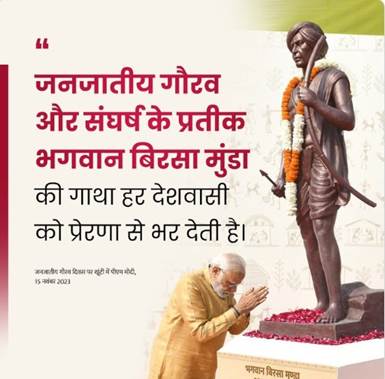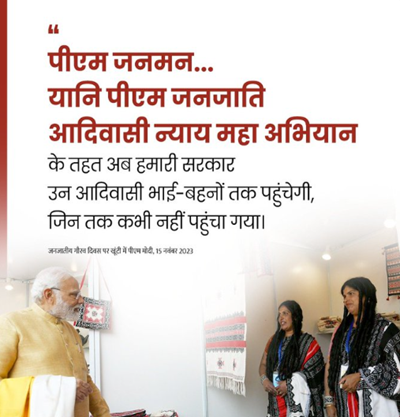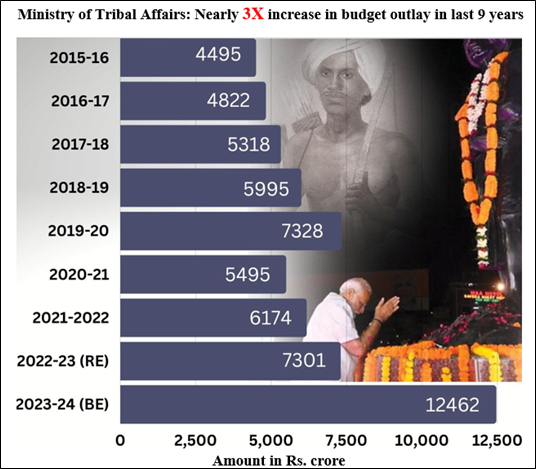Others
Empowering Tribals, Transforming India
Posted On: 14 NOV 2023 1:29PM
India will prosper when our tribal communities prosper, the welfare of tribal communities is our foremost priority.
Prime Minister Narendra Modi
Unity in diversity is one of the most spectacular features of the population of India. India has the second-largest tribal population in the world. As per the Census 2011, the tribal population constitutes about 8.9% of the total population in India. The tribal people throughout the country have rich traditions, cultures and heritage with unique lifestyles and customs.
Tribal movements like the Khasi-Garo movement, Mizo movement, Kol movement, etc. are integral chapters in India’s history and struggle for independence. Be it the bravery of Gond Maharani Veer Durgavati or the sacrifice of Rani Kamalapati; the country cannot forget the same. The struggle of Veer Maharana Pratap cannot be imagined without the brave Bhils who fought shoulder to shoulder and made sacrifices. There are many Adivasi heroes who have sacrificed their lives in the struggle for the country’s freedom.
Commemorating the sacrifice of Tribal freedom fighters and marking their legacy, the Union Government decided to observe the birth anniversary of one of the great Freedom Fighters, Bhagwan Birsa Munda, as Janjatiya Gaurav Divas with effect from November 15, 2021.

For the first time in the country after Independence, the art and culture of the tribal society and their contribution to the freedom movement and nation-building are being remembered with pride, and they are being honoured on such a grand scale. This declaration acknowledges the glorious history of tribal communities and recognises their efforts towards preserving tribal cultural heritage.
Further, on November 15, 2023, Prime Minister Narendra Modi became the first Prime Minister to visit Ulihatu Village, the birthplace of Bhagwan Birsa. In addition, the Prime Minister launched the Pradhan Mantri Janjati Adivasi Nyaya Maha Abhiyan (PM JANMAN), with a budget of around Rs 24,000 crore for the overall development of Particularly Vulnerable Tribal Groups (PVTGs). The Mission will be implemented through the convergence of 11 interventions of 9 Ministries.

There are 75 PVTGs across 18 States & UTs who are living in 22,544 villages (220 districts) with a population of around 28 lakhs. These tribes stay in scattered, remote & inaccessible habitations, often in forest areas and hence a mission is planned to saturate PVTG families and habitations with basic facilities such as road and telecom connectivity, electricity, safe housing, clean drinking water and sanitation, improved access to education, health and nutrition and sustainable livelihood opportunities.
Empowering the Tribal Communities
Recognizing the need to protect the socio-cultural fabric of tribal communities and underscoring their role in nation-building, the makers of the Constitution of India made special provisions for the protection of tribal culture and the development of Scheduled Tribes. These include the conservation of their language, script and other cultural elements, ensuring their educational interests, providing economic safeguards and taking steps for political empowerment.
Apart from the above constitutional safeguards, a separate Ministry named the Ministry of Tribal Affairs was set up in 1999 with the objective of providing a more focused approach to the integrated socio-economic development of the Scheduled Tribes (STs). The programmes and schemes of the Ministry are intended to support and supplement other Central Ministries, State Governments and voluntary organizations and to fill critical gaps in institutions and programmes, taking into account the situation of STs through financial assistance.
In another initiative for tribal empowerment, the Scheduled Tribes and Other Traditional Forest Dwellers (Recognition of Forest Rights) Act, 2006 (In short FRA) was enacted by the Parliament to recognize and vest forest rights in the Forest Dwelling Scheduled Tribes and Other Traditional Forest Dwellers who have been residing in forest land for generations, but whose rights on ancestral lands and their habitat were not adequately recognized resulting in historical injustice to them. The Act came into effect on 31.12.2007. The Scheduled Tribes and Other Traditional Forest Dwellers (Recognition of Forest Rights) Rules, 2007 were notified on 01.01.2008.
Under this act, total Community rights given up to May 2014 was 23,578 whereas during the period from 2014 to June 2023, 86,621 community rights have been given across the country. The total extent of land distributed during the period from the inception of FRA to May 2014 was 55.30 lakh acres whereas, during the period from 2014 to June 2023, 122.60 lakh acres have been given, which is almost double the figure during the period till May 2014. A total of 177.90 lakh acres of forest land (47.56 lakh acres individual and 130.34 lakh acres community) has been distributed up to 30.06.2023 across the country.
Eklavya Model Residential Schools (EMRS) have been set up to provide quality education to ST students (Class VI-XII) in remote areas through residential schooling facilities. Presently, more than 1.2 lakh students are enrolled in 401 EMRS. It is noteworthy to know that the number of female students (60,815) in EMRSs exceeds that of male students (59,255). Moreover, a total of 38,000 teachers and support staff are being recruited for the Ekalavya Model Residential Schools which will benefit 3.5 lakh tribal students.
A number of Fellowship and Scholarship Programmes have also been launched to provide financial assistance to ST students for studies ranging from pre-matric and post-matric levels to the pursuit of higher education and studies abroad. Notably, during the last nine years, a total of 3.15 Crore tribal students have received scholarships/fellowships of over Rs. 17,087 Crore (from April 2014 till September 2023).
Prioritizing the welfare of tribal communities, the budget allocation of the Ministry of Tribal Affairs has been substantially increased from Rs.4295.94 crore in 2013-14 to Rs.12461.88 crore in 2023-24 i.e., an increase of around 190.01%.
Funds are released to States under Article 275(1) of the Constitution to enable them to meet the cost of such schemes of development as may be undertaken by the State for the purpose of promoting tribal welfare. Under the Pradhan Mantri Vanbandhu Vikas Yojana, a venture capital fund has been set up to promote entrepreneurship/start-up projects by ST youth. Minimum Support Price (MSP) is ensured for Minor Forest Produce, and marketing support for tribal products is provided through the Pradhan Mantri Jan Jatiya Vikas Mission. Under this mission, the total number of Van Dhan Vikas Kendra (VDVK) sanctioned is 3958 while an amount of Rs. 398.49 crore has been disbursed. A total number of 183412 tribal persons is associated with this scheme. In addition, financial aid is provided to Voluntary Organizations working for the welfare of Scheduled Tribes for projects in education, health and livelihood.

TRIFED, (Tribal Cooperative Marketing Development Federation of India) supports retail marketing for livelihood development among tribal communities of India. A provision of Rs. 288 crores has also been made in the annual budget estimate for the fiscal year 2023-24 to be implemented through TRIFED, specifically through the formation of Self-Help Groups and producer enterprises.
Under TRIFED, a Central Sector Scheme ‘Marketing and Logistics Development for Promotion of Tribal Products from North -Eastern Region (PTP-NER)’, was launched for the benefit of Scheduled Tribes of the Northeastern Region, in Manipur on 18th April, 2023.
Improved Infrastructure and Livelihood Opportunities
The Pradhan Mantri Adi Adarsh Gram Yojana (PMAAGY) aims to provide basic infrastructure in villages with a significant tribal population. Under the scheme, 36428 villages having 50% tribal population and 500 Scheduled Tribes (STs) have been identified for providing basic infrastructure facilities in these villages, which includes villages in the Aspirational Districts identified by NITI Aayog. Out of the total Aspirational Districts, 86 Districts are common wherein 10509 villages are covered under PMAAGY.
Initiatives for Better Health Outcomes
Under the Ministry of Health and Family Welfare, the National Health Mission has prepared a comprehensive guideline to control and prevent Haemoglobinopathies, including Sickle Cell Disease, and has disseminated the same to the states.
The government has worked to ensure the near-total eradication of Sickle Cell disease, which is a genetic blood disorder affecting the tribal population in Central, Western and Southern India. In this regard, the Sickle Cell Anaemia Elimination Mission was launched by the Prime Minister from Madhya Pradesh on 1st July 2023. The Mission aims to provide affordable and accessible care to all Sickle Cell Disease patients, quality of care for SCD patients and reduction in the prevalence of Sickle Cell Disease through awareness creation, universal screening of 7 crore people in the age group of 0-40 years in affected 278 districts of tribal areas, and counselling through collaborative efforts of central ministries and state government. A total number of 58.6 lakh people has been screened under this Mission.
Other health-related schemes, such as Mission Indradhanush, aimed at ensuring full immunization with all available vaccines for children up to two years of age and pregnant women and provision of free vaccines against COVID-19, have laid stress on Adivasi communities. Another important scheme with special reference to tribal groups is the Nikshay Mitra initiative to ensure additional diagnostic, nutritional, and vocational support to those on tuberculosis treatment.
In addition to the above, the Support to Tribal Research Institute (TRI) scheme aims to strengthen TRIs to carry out research, documentation, training and capacity-building activities and serve as a knowledge hub catering to overall tribal development.
Other Initiatives for Holistic Welfare of Tribal Communities
Apart from the schemes that are administered by the Ministry of Tribal Affairs, the focus is given to tribal welfare by initiatives under other ministries of the Government, cutting across sectors and domains. From housing and road connectivity under Pradhan Mantri Awas Yojana and Pradhan Mantri Gram Sadak Yojana, respectively, to financial empowerment through Jan Dhan accounts, formation of Self-Help Groups and MUDRA Yojana, various Government programmes have greatly benefitted the tribal communities. Swachh Bharat, Gobardhan Scheme and Pradhan Mantri Matru Vandana Yojana are some other such schemes, as highlighted by Prime Minister Narendra Modi in his address on the occasion of Janjatiya Gaurav Divas 2022. The nation is moving with the energy of ‘Panch Pran’ to realize the dreams of Bhagwan Birsa Munda and crores of Janjatiya brave hearts, as was also underlined by the Prime Minister.
Honouring and Celebrating India’s Tribal Communities
10 Tribal Freedom Fighters’ Museums have been sanctioned in States where tribals lived, struggled against the British and refused to bow down. On November 01, 2022, Prime Minister Narendra Modi called for preparing a roadmap to develop Mangarh Dham in Rajasthan’s Banswara district. Mangarh Dham, situated near the Rajasthan-Gujarat border, is the site where over 1500 Bhil freedom fighters lost their lives in 1913 in a mass shooting by the British. The Mangarh Dham will be developed as a joint project of the governments of Rajasthan, Gujarat, Madhya Pradesh and Maharashtra, as a national memorial showcasing tribal legacy and their rich cultural heritage.
The focus of Government has been overall development of STs and to bring them at par with the other communities in the country. Government has taken various steps for the development of tribals under Development Action Plan for Scheduled Tribes (DAPST), of the schemes of the obligated Ministries/Department. There have been considerable improvements in the socio-economic conditions of the Scheduled Tribes (STs), for example, the literacy rate for STs has improved from 59% (Census) in 2011 to 71.6% (as per Periodic Labour Force Survey (PLFS), July 2020 - June 2021), bringing down the gap between overall and ST literacy from 14 percent between 2001-2011 to 7.5 percent between 2011-2021. Gross Enrolment Ratio (GER) at upper Primary level has improved from 91.3 (2013-14) to 98 (2021-22); GER for ST students at secondary level (IX-X) has increased from 70.2 (2013-14) to 78.1 (2021-22); GER for ST students at senior secondary level (XI-XII) has increased from 35.4 (2013-14) to 52.0 (2021-22) and GER for ST students at higher education level has increased from 13.7 (2014-15) to 18.9 (2020-21).
All these initiatives, along with other steps taken by the government, have paved the path of bringing the tribal communities into the mainstream while honouring their cultures, legacies and ways of life.
****
Nimish Rustagi/Himanshu Pathak/Ritu Kataria/ Shashi P Narayan
(Features ID: 151692)
आगंतुक पटल : 439
Provide suggestions / comments